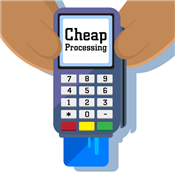Credit Card Processing Fee Calculator
Are your credit card processing fees too high? What is a fair rate? Use our calculator tool to see if you are overpaying.
 |
Square Reader: Free Mobile Credit Card Reader
- Pay 2.6% + 15¢ Per Swipe for Visa, Mastercard, Discover, and American Express
- Accept Credit Cards Anywhere
- Fast Setup, No Commitments
Your monthly processing statement can be dozens (or even hundreds!) of pages. It's nearly impossible to go through it and decipher just how much your processing really costs.
Our calculator tool will help you determine your true processing rate. We'll help you figure out if it's too high and what you can do to lower it.
Calculate Your True Processing Rate
Your effective processing rate is your rate after adding up all processing costs, including interchange fees, processor markups, and any monthly service fees you're paying. It's the true percentage you're paying for every credit card transaction.
To calculate your effective processing rate, look at your past monthly statement. You will need two numbers:
- The total processing fee charged
- Total amount of you processed
Then use our calculator to find your true effective processing rate.
In other words, the effective rate is how much it costs you to process each credit card sale. For example, if it costs you $450 to process $15,000 worth of card sales, then your effective processing rate is 3%. Each dollar you process costs you 3 cents.
Now you have an idea of what exactly you're paying for each credit card transaction. But what does it mean? Is it good, or high? Let's see.
Switch to a processor that won't rip you off.Find a credit card processor with lower rates and transparent pricing. Choose your state to get started.
What Is a Good Effective Rate?
A fair effective rate is between 2.5% and 3.25% (3.5% at most). If you're paying any more than that, your processor provider markup is likely too high.
In general, physical stores where you swipe credit cards in person will have the lowest effective rate. You want your rate to be on the lower end of that spectrum.
Online stores will have higher rates closer to 3.5%. This is because there's higher risk of fraud when the credit card is not present during transactions.
There are unique situations where your effective rate may be higher than 3.5% and is still considered normal. We'll get into that later.
What Goes Into Your Effective Processing Rate?
To know if your rate is fair, first it's important to understand what it includes. Your effective processing rate includes:
- Interchange fees: These fees are paid to the card issuing banks and are non-negotiable. The average interchange rates are 1.7% - 2%. They should be the MAJOR BULK of your processing rate, making up 70% - 80%.
- Assessment fees: These are paid to the card networks and are non-negotiable. The average assessment fee is 0.13% - 0.14%, so it's just a very tiny percentage.
- Processor markup: This is your merchant account provider's commission for each transaction. This should make up just 10 - 15% of your total processing rate.
If your effective rate is too high, it's probably because your provider has a high markup. This is where you want to reduce rates.
- Service fees: This includes any service fees you're paying, like monthly fee, payment gateway fee, PCI compliance fee, statement fee, etc.
Go through your statement and identify all these types of fees. If they add up to a lot, then you probably have too many "junk" fees. Consider switching to a provider without hidden junk fees.
How to Lower Processing Rate
If your effective rate is over 3.25%, then you're most likely paying too much.
If you like your current provider, you can try negotiating with them first. Remember that the interchange rates and assessment fees are not negotiable. BUT you can negotiate anything the provider has control over. This includes:
- The processor's markup
- Annual or monthly fees
- Payment gateway / virtual terminal fee
- Equipment fee / setup costs
- PCI compliance fee
Reducing any of these fees will help lower your effective processing rate. Ideally, you want your provider fees to be no more than 20% of your entire processing cost.
The key to negotiating is to be a valuable client. The more sales you have, the more negotiation power you have.
It's also important to have a good history. This means always making payments on time and having fewer chargebacks. By being a good client, the provider is more likely to work with you to cut down fees.
Here is the general rule of thumb:
- If your business has a small average ticket size, negotiate the fixed fee.
For example, if your processing rate is Interchange + 0.2% + $0.10, getting it down to + 0.2% + $0.05 will save you 5 cents each purchase. That can add up to a lot of savings if you're processing thousands a month.
- If your business has a large average ticket size, negotiate the percentage markup. For instance, you can cut it down to 0.15% + $0.10.
Also see our 8 ways to lower credit card processing fees for more practical tips.
If you don't have negotiation power right now (or your provider refuses to lower), then consider switching providers. Comparing effective rates will help you to see which one offers the best deal.
Compare Top Credit Card Processors
Find out how much you could save when you switch to a different processor.
First Month Free
- Flat Monthly Subscription Price, Starting at $99
- 0% Markup on Direct-Cost Interchange
- 24/7 Support
U.S. Bank Payment Solutions - Earn up to $1,000 in 3 months
Earn up to $1,000 in statement credits over 3 months when you open a new U.S. Bank Payment Solutions account and complete qualifying activities. Member FDIC.
Offer:
- Open, and be approved for, a new U.S. Bank Payment Solutions Merchant Account (MID) by December 31, 2025.
- Account must be open and actively accepting and settling payments at the time the monthly statement credits are being calculated and applied in order to receive the rebate. Merchant account must be in good standing with no outstanding recovery balance.
- Get merchant fees refunded up to $1,000 over three months
How to Use Effective Rate to Compare
Calculating the effective rate will help you compare among credit card processing providers.
You can't just look at individual fees. One processor may have lower transaction markups but higher service fees. Another one may have higher markups but no miscellaneous fees. It's hard to know without comparing the effective rate.
Take this example. Let's assume you have $10,000 in sales each month, with $50 average ticket size. That's 200 sales total per month.
If you're comparing between these 3 providers, here's what you would get:
| Processor 1 | Processor 2 | Processor 3 | |
|---|---|---|---|
| Average interchange rate | 1.81% | 1.81% | Included |
| Assessment fee | 0.13% | 0.13% | Included |
| Processor markup | 0.2% + $0.10 | $0.15 | 2.7% |
| Monthly fee | $10 | $50 | $0 |
| Payment gateway fee | $10 | $0 | $0 |
| PCI compliance fee | $10 | $0 | $0 |
| Total monthly processing cost | $264 | $274 | $270 |
| Effective rate | 2.64% | 2.74% | 2.7% |
In this example, Processor 1 has the lowest overall effective rate. Because each processor has a different pricing structure, you wouldn't know that unless you took everything into account.
Why Your Processing Rate May Be High
As mentioned before, there could be good reasons why your effective rate is high. This could be if:
You're a high-risk business
If your business is in the "high-risk" category, it's certain that you will have higher processing rates. In general, you can expect processing rates to be 3.5% - 5%.
High risk businesses can include:
- Industries with a high risk of chargebacks and fraud
- Industries with high rate of failure
- Industries that require a lot of legal regulation
- If you have a history of bad credit
- Companies with large transaction amounts
Some common high-risk businesses are: travel companies, auto parts and accessories, financial services, construction, and adult entertainment.
You have a very small average ticket size
If you typically have super-tiny average transactions, then the per-transaction flat fee will drive up your processing costs.
For example, say your rate is Interchange + 0.2% + $0.10. If you're usually processing $10 sales, $0.10 each sale will make a much larger dent for you than for businesses with bigger sales.
You take lots of international payments
If you're an online business that sells your goods or services globally, your rate will be higher. For example, a lot of providers add an additional 1% for international transactions. And if there's a currency conversion fee, then that's another extra charge.
You're a luxury business
Then there's a good chance your customers usually pay with high-end credit cards. For example, if you run a luxury resort, a lot of customers probably pay with a premium travel rewards card.
These types of cards have the highest processing fees because banks use that to make up for the rewards. The overall processing fee can be as high as 4%.
Bottom Line
Knowing your effective processing rate is the first step to determining if you're overpaying or not.
If your effective rate is too high, then consider negotiating with your current merchant account provider or switching. If you're comparing rates between different providers, be sure to compare the overall effective rate instead of individual fees.
Anna G is a research director at CreditDonkey, a credit card processing comparison and reviews website. Write to Anna G at feedback@creditdonkey.com. Follow us on Twitter and Facebook for our latest posts.
Note: This website is made possible through financial relationships with some of the products and services mentioned on this site. We may receive compensation if you shop through links in our content. You do not have to use our links, but you help support CreditDonkey if you do.
Not sure what is right for your business?
|
|
|
Answer a few short questions in our credit card processing quiz to receive tailored recommendations to help you keep more profits.
|
|
|









